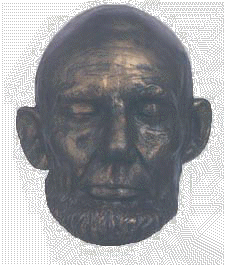Abraham Lincoln Art Gallery. ComLincoln's Image Essays on Art, Sculpture, and Abraham Lincoln By Bronze Portrait and Figure Sculptor James J. Nance
Sculptor James Nance's research process and the use of life masks during the creation of his twin portrait of transition of Abraham Lincoln, "Immortal Conscience" and "Prairie Lawyer."
|
|
Artist Essays
Essay 3 of 10
Researching Abraham Lincoln's ImageWhen this project began, I collected a great many pictures of Mr. Lincoln and enlarged them to life size copies in my darkroom. I soon realized that every picture of Mr. Lincoln looked like an entirely different person. This was due in part to his incredibly complicated face and the ravages of time and in part to the distortions and limitations inherent in the early cameras. To create the image I wanted, I needed more than a collection of photographs; I needed a lifemask.
The Research Process Two life masks were made of Abraham Lincoln. The first, shown on this page by artist Leonard Volk, was made in March of 1860 and shows a robust Lincoln without a beard. The second, by sculptor Clark Mills, is a full head cast made in 1865, just two months before Lincoln was assassinated. The latter reveals a fragile face, ravaged by the pressures of presiding over the most devastating war of our history, the Civil War. The trauma of the struggle revealed by that mask has often led others to call it a death mask, but it is not.
After several months of nationwide correspondence with knowledgeable curators of Lincoln artifacts, I was graciously granted permission by the staff at the Lincoln Museum to come to Ft. Wayne to make my own molds of their priceless Volk and Mills masks. With plaster copies made from these molds and with my photographic enlargements of every known Lincoln pose, I now possessed all of the physical research material I needed to proceed with the portraits. Before I could begin the sculpture and before I could hope to capture Lincoln's spirit in clay, I needed to become intimately familiar with Abraham Lincoln the person.
In my pursuit of this elusive goal, I relied on my years of Lincoln study as a solid foundation and expanded my knowledge and understanding with an intensive reading program of Lincoln material. I frequently traveled to Lincoln sites around the country to experience first hand his life surroundings and attended numerous symposia presented by leading Lincoln scholars. For two years, I totally immersed myself in Abraham Lincoln, searching for the understanding that would lead me to his spirit, and the hope that I could express this understanding in these portraits. |
 Masks have been used for hundreds of years by sculptors and painters as stand
ins for subjects who were unavailable. The early mask casting process
required the subject to endure a long period of discomfort, and the unnatural
compression of the skin and facial muscles by the plaster often resulted in a
severe, deathly look. Even with these major limitations, masks were and
still are a very useful reference tool which can guide the artist in proper
proportion and skull structure. A mask is not a work of art or sculpture, only a
tool.
Masks have been used for hundreds of years by sculptors and painters as stand
ins for subjects who were unavailable. The early mask casting process
required the subject to endure a long period of discomfort, and the unnatural
compression of the skin and facial muscles by the plaster often resulted in a
severe, deathly look. Even with these major limitations, masks were and
still are a very useful reference tool which can guide the artist in proper
proportion and skull structure. A mask is not a work of art or sculpture, only a
tool.  When one views a work of art, one is really seeing the
subject through the eyes and heart of the artist. The artist must be so
familiar with the subject's character that he or she can bring personal insight
and personal feeling into the work, as well as craftsmanship and artistry.
Only then can an artist hope to achieve expressiveness and sensitivity and raise
the work to the level of fine art.
When one views a work of art, one is really seeing the
subject through the eyes and heart of the artist. The artist must be so
familiar with the subject's character that he or she can bring personal insight
and personal feeling into the work, as well as craftsmanship and artistry.
Only then can an artist hope to achieve expressiveness and sensitivity and raise
the work to the level of fine art. 
